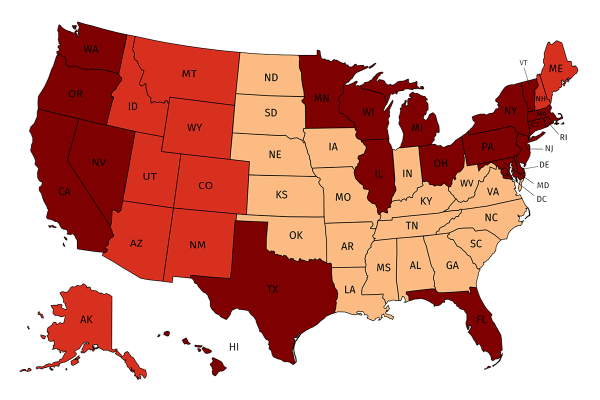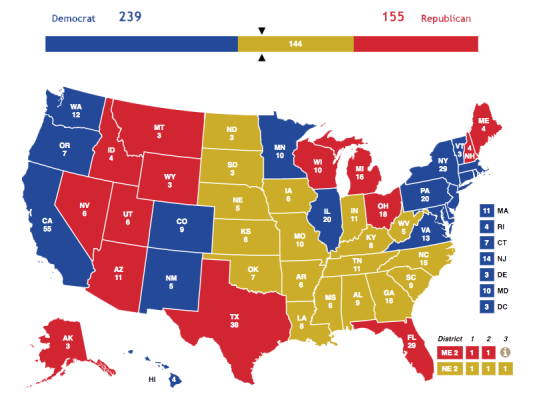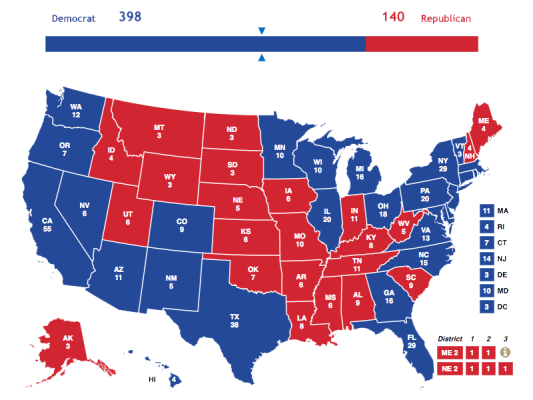
In August 2016, I was penning an article titled “The Coming Republican Civil War”. The premise was simple: after a self-inflicted Trumpian defeat in November, the party of Lincoln would tear itself asunder assigning blame and shedding factions.
But Hillary lost. For a few brief months, the Grand Old Party looked triumphant.
Not so much anymore.
The long-term trajectory of the Republican Party isn’t great; factional infighting has already sunk several attempts to roll back the Affordable Care Act and by the end of the month we’ll know just how deep the divides go should tax reform and the Graham-Cassidy health-care bill fail.
Broad tent
Political scientists have long understood the broad tent of the Republican Party: the business/economic conservatives, the cultural/religious conservatives, the foreign-policy-driven neoconservatives and the libertarians and associated skeptics.
For much of its history, the big tent of the Republican Party has more often than not produced a business/neoconservative-dominated party. The business elite dictated domestic policy with lip service to the cultural wing while the neocons ran foreign policy. That’s how the George W. Bush Administration played out: tax cuts and pro-business education reform at home, the War on Terror abroad, with rhetorical sops for abortion foes and marriage equality opponents. Rarely did the business/neocon indulge the cultural conservatives on anything substantive.
So it was inevitable that one day those cultural conservatives would get wise and take over the party.
That’s exactly what happened with Donald Trump, who had no specific plans for the business folks, the neocons or the libertarians, but had plenty of cultural salvos that thrilled white nationalists and their allies.
And that’s where cracks become fissures. The cultural wing believes it has finally elected a true believer to the White House. If they haven’t, if the party fails them yet again, if this last great push flops, party unity is unlikely in the extreme.
There’s not much to please the other factions yet either. Failure to repeal Obamacare or cut taxes has upset the business faction and the libertarians; Trump’s saber-rattling has filled isolationist libertarians with unease. None of the major factions have an achievement they can hold onto and all of them can cast blame to the others.
The situation is ripe, in other words, for a split.
It’s probable that a full-on Republican civil war won’t happen until one of three conditions are satisfied: Republicans lose Congress in 2018, Trump loses in 2020 or Trump is impeached and convicted/resigned before 2020. After a seminal shock like that, the Grand Old Party might finally turn on itself.
The possible geography of the Republican tent

I constructed the above map to show the approximate geographic bases of each of the three major wings of the Republican Party. This is important going forward, since it allows us to conceptualize the impact on the Electoral College, Congress and state-level politics.
It isn’t that each of these states lacks the other factions; it’s that each of these states has the conditions likely to empower leaders representing these specific factions. Since I couldn’t find any data showing the ideology of Republican voters state-by-state, this is an approximation.
I labeled states where those economic interests and tax cuts override cultural considerations “business conservatives”. The Koch brothers of New York, for example, or the oil tycoons of Texas. The Midwest, the coasts, Florida and Texas are their strongholds.
The cultural conservatives, on the other hand, are most likely to gain power throughout the South and Great Plains states – places where economic considerations are secondary to evangelical values and unease over racial and ethnic diversity.
Finally, the libertarians hold the Mountain States and Southwest, topping off in New Hampshire, Maine and Alaska, as the redoubts of the individualists seeking to make it on their own. There is also a dosage of Mormonism within this faction; as a religious minority, Mormons have long preferred the hands-off approach of libertarians, even if they are also often motivated by the arguments of the business class.
The neoconservatives, being so small, don’t have a base, except perhaps for Washington DC.
Scenario 1: A Wall Street party

Led to the electoral cliff by Trump and his white nationalists, the business faction decides that politics is too serious to be left to the unwashed masses. Using their superior funding and organization, they hijack control of the party, rewrite primary rules to shut out cultural conservatives, collaborate with the Democrats to redraw congressional districts and perhaps even restore the Fairness Doctrine, whose absence gave such form and function to the right’s cultural discourse.
As the immigrant-bashing, abortion-opposing, Christian-values-pushing politicians are driven to irrelevance, this Republican Party looks a lot more like Great Britain’s Tories, with people like Mitt Romney and Jeb Bush gatekeeping the party’s long-term interests.
Disciplined and profit-oriented, the Wall Street party revitalizes moribund Republicans in once-deep blue states like New York and California and is competitive in the Rust Belt. Libertarians tolerate their rule, opening the door to victories in Mountain states, Maine, Alaska and New Hampshire.
But the purge enacts a toll. While the Wall Street party amasses great war chests from its wealthy donors, grassroots cultural conservatives bolt it in droves. They found America First – a callback to their heyday of the Trump campaign – which dominates the heartland. Believing that they are a secret majority of the country, they rebuff efforts to return to a Republican tent controlled by the hated 1 percent.
This splits the country three ways: the Democrats hold onto their traditional bases while the Republicans and America First divvy up the old Republican empire. The Midwest, the new national battleground, splits between Democrats, Republicans and America First, to no one’s benefit. The Wall Street party’s newfound strength in Democratic strongholds like Illinois, New York and California is not enough to take those states; while state legislatures see a revitalization of Republican power, on the national stage they stay blue.
This leads to an awkward time: split between three factions that mutually despise one another, there is no clear way forward to govern. The presidency goes to the House, where a divided chamber wrangles unpredictably for the White House. A compromise emerges, but its form and function is deeply unknown. For at least one election cycle, the federal government either fails to govern entirely or it is forced to experiment with coalition government for the first time in its history.
No clear winner: the business class takes the Republican Party.
Scenario 2: America First

After a bruising defeat, the cultural conservatives decide it was not Trump, or even the Republican Party, that betrayed the cause, but Republicans In Name Only, propped up by the globalist 1 percent. The Breitbart crowd, the evangelical megachurch leaders and the white nationalists flood the primaries before the business class has a chance to game the system in their favor. They conduct a party-wide purge, leaving only isolated pockets of business-class Republicans in a sea of cultural conservatives.
The business class realizes they’ve lost the party; their economic interests will be subsumed to cultural warfare. Rather than try to compromise their way to power, they begin formidable third-party challenges. A revitalized Reform Party emerges. They manage to get power in Texas, part of the Midwest and Florida.
The culture crowd overreaches. While they target the business conservatives, they equally alienate the libertarian faction, who worry the cultural conservatives will enact far-reaching social legislation against drugs, marriage equality, religious freedom and immigration. Rather than join with the discredited New Reform Party, the libertarians openly rally to the already-established Libertarian Party. For the first time in its history, the Libertarian Party wins power in multiple Mountain states as well as bits of New England.
This produces a four-party split.
It isn’t as unstable as the Wall Street party scenario; with the Democrats enjoying much of their traditional power base, all it would take is for some of the Libertarian Party to join in coalition with the Democrats to get America functioning again. The Republicans and New Reform Party could thus be excluded from power while the Libertarians and Democrats make common cause on the social issues they care about.
This would be a huge win for American libertarians, akin to the opportunity Britain’s Liberal Democrats enjoyed in 2010. But like the LibDems, the libertarian movement could choke on their success if they played their cards wrong.
The libertarians (grey) become kingmakers while the business class (yellow) holds onto its tax and job-based constituents and the cultural conservatives take the South and Great Plains.
Scenario 3: The Ron Paul party

When two giants struggle, opportunity can emerge for the little guy.
Should the Wall Street and America First scenarios either fail to occur or should one happen and the resulting conflict gives power fully to the Democrats, a door would open for the libertarians, the smallest of the Republicans’ great factions.
The Ron Paul party could referee between the cultural conservatives and the business class to rebuild a shattered tent. They could even peel away aging liberal voters from the Midwest and coasts by appealing to lax drug laws and more open borders.
They would have trouble rallying the cultural conservatives to their cause, but have less difficulty getting the business class behind them. Their willingness to give ground on gay rights and abortion would discredit them before the megachurch pews, yet rather than forming a third party these voters simply stay home.
In the short term, the demoralization of the cultural conservatives would make governing a huge challenge. Democrats could take advantage of this to flip critical states like North Carolina, Texas, Georgia and Arizona. Though united by the libertarians, this Republican Party would take a bruising without their social conservatives.
Yet over time, this scenario may also be the most likely one to rehabilitate the Republican Party in the 2020s.
If the Democrats enjoyed too wide a margin of victory for too long, corruption and overreach would produce an inevitable backlash, even in Democratic strongholds. Millennials might be tempted, especially as they age, to embrace some of the live-and-let-live libertarian approach of this new Republican Party, turning former Dem fortresses like New York and California into something much more like battleground states. Other recently flipped states could slide back for the same reason.
What are the odds? We’ll know more by the end of September
This isn’t to gloss over the very real differences lurking inside the Democratic Party (and a Democratic civil war will be the subject of a future article). But of the two parties, the Republicans are under the greatest current strain and failure to legislate this month makes any of these scenarios all the more possible.
From the standpoint of stability, scenario #3 is preferable. It would preserve the old two-party system and allow the Republicans to eventually rally back to relevance.
But scenario #2’s dynamism could knock loose the staid politics of the United States and introduce radical, and potentially beneficial, ideas to the body politic.
Even scenario #1 would be enough of a shakeup to open the door to substantial change.
None of these scenarios result in a literal civil war; America’s political system is able, at least in the short term, to absorb the shocks of this kind of upheaval. In many ways, it’s long overdue. The 1968 realignment create uneasy alliances that could not last forever. Just as the Democrats one day had to choose between their Northern liberals and their Southern segregationists, the Republican Party will soon have to choose between its factions as well.
This story first appeared on American Politics Made Super, September 20, 2017.
